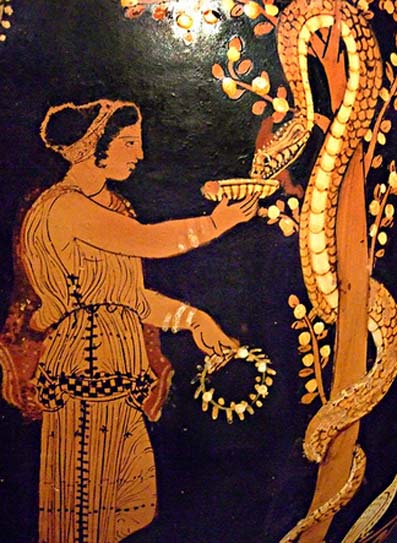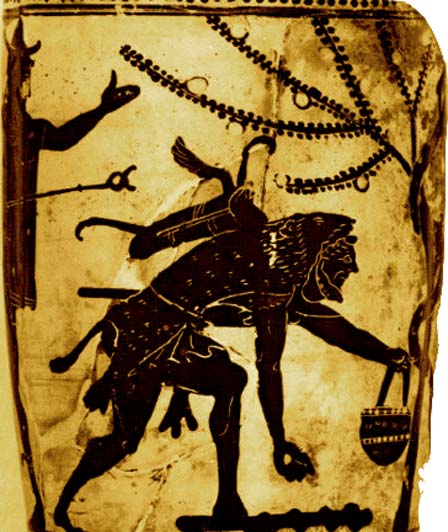Garden of Eden Depicted in Ancient Greek Religious Art
If the early chapters of the Book of Genesis present a true account of human origins, then ancient secular human history must connect in significant ways to that account.
In fact, ancient Greek religious art connects in very significant ways with Genesis. While Genesis describes the early events and people in humanity’s past, the Greeks depicted those same events and people – except from the point of view that the serpent enlightened, rather than deluded, the first couple in paradise.
The Greeks remembered the original paradise, calling it the Garden of the Hesperides, always depicting it with a serpent-entwined apple tree. The Book of Genesis doesn’t say what kind of fruit it was: It’s from the Greek tradition we get the idea that Eve ate an apple.
- Divine, Forbidden and Dangerous? Magic Apples in Ancient Mythology
- Immortality, the Elixir of Life and the Food of the Gods

Oil Jar (lekythos) with the serpent-entwined apple tree in the Garden of the Hesperides. Greek made in Paestum South Italy 350-340 BC Terracotta. (Mary Harrsch/CC BY NC SA 2.0)
Zeus and Hera – the Original Occupants of the Garden
Both the ancient commentator Apollodorus and the Greek playwright Euripides describe Zeus and Hera as the original occupants of the Garden of the Hesperides. To the Greeks, they were the first couple, a match for the Adam and Eve of Genesis.

Zeus and Hera, the first couple according to the Greeks, seated together on the east frieze of the Parthenon, from about 435 BC. (Author provided)
The Judeo-Christian tradition considers Adam as the father of all humanity. The term “father Zeus” is a description of the king of the gods that appears over 100 times in the ancient writings of Homer. According to the ancient poet Hesiod, Zeus is “the father of gods and men” – the gods being deified ancestors.
Genesis 3:20 describes Eve as “the mother of all the living.” In a hymn of invocation, the 6th-century BC lyric poet, Alcaeus, refers to Hera as “mother of all.” As the first wife, the Greeks worshipped Hera as the goddess of marriage; as the first mother, the Greeks worshipped her as the goddess of childbirth.
Both the Judeo-Christian tradition and the Greek religious tradition insist that their respective first couples came out of an ancient paradise with a serpent-entwined fruit tree. Two opposite spiritual standpoints—the former looking to the Creator as the source of truth, and the latter looking to the serpent for it—share the same factual basis.
Names of Hesperides Describe The Garden
The Hesperides, the nymphs who tend to the ancient garden, its tree, its apples, and its serpent, get their name from Hespere in Greek, which means evening, signifying the West where the sun sets.
This matches the Genesis account which describes civilization developing to the east of Eden. A return to Eden would mean traveling west. The Greeks put the Garden of the Hesperides in the Far West.
The Garden of the Hesperides was depicted on the lower panel of a water pot from about 410 BC. In this representation, the serpent entwines the apple tree with its golden fruit. The names of the figures are written on the vase. Two of the Hesperides, Chrysothemis (Golden Order) and Asterope (Star Face) stand to the immediate left of the tree.

The Garden of the Hesperides depicted on the lower panel of a red-figured hydria from about 410 BC. (Author provided)
Chrysothemis moves toward the tree to pluck an apple. Asterope leans pleasantly against her with both arms. To the left of them, Hygeia (Health) sits on a hillock and holds a long scepter, a symbol of rule, as she looks back towards the tree. To the right of the apple tree, Lipara (Shining Skin) holds apples in the fold of her garment, and raises her veil off her shoulder.
The names of the Hesperides describe what the garden is like. It’s a land of soft starlight, gold for the taking, perfect health, and wondrous beauty.
Apollodorus, writing in the 2nd-century BC, gives four different names for the Hesperides: Aegle (Dazzling Light), Erythia (Red Land), Hesperia (Evening Star), and Arethusa (Water Fountain).
The sound of a water fountain is one of the most peaceful sounds. What an enchanting and delightful place! The Hebrew word for Eden means “to be soft or pleasant,” figuratively “to delight oneself.” The Garden of the Hesperides is the Greek version of the Garden of Eden.
Herakles Goes for the Apples
The seated man on the vase to our right of the tree is Nimrod/Herakles. The goal of Nimrod/Herakles in the post-Flood world was to push Noah and his God out of the picture, dispatch those who disagreed with his own mankind-exalting rule, and get back to the ancient garden for another bite of the serpent’s apple, its anti-Creator “enlightenment,” and the promise of immortality without God.
On a vase-depiction from 450 BC, Nimrod/Herakles makes off with the apples as one of the Hesperides gestures for him to stay with them.

One of the Hesperides gestures for Herakles to stay with them as he makes off with the apples from the serpent's tree (Author provided)
Notice on the vase images above, and on the vase images, sculptures, and coin below, spanning over seven centuries (500 BC to 250 AD), that the serpent is always depicted in a friendly posture.
On this vase from about 350 BC, one of the Hesperides tends to the serpent as the other tends to the tree. To our right, Nimrod/Herakles holds one of the serpent’s apples in his hand.

350 BC representation of the Hesperides tending to the tree and serpent. (wcn4u)
On a vase from about 340 BC, one of the Hesperides tends to the serpent, another tends to the tree, and a third tends to her own loveliness.

Vase from ca. 340 BC showing the Garden of the Hesperides. (Author provided)
On the following vase from about 400 BC, Nimrod/Herakles appears to be chatting with one of the Hesperides who sits in front of the serpent-entwined tree.

Vase from about 400 BC showing Nimrod/Herakles talking to one of the Hesperides as she sits in front of the serpent-entwined tree. (Author provided)
On a vase from about 525 BC, Cush/Hermes, carrying his two-headed serpent staff representing the serpent’s rule in the pre-Flood world and now in the post-Flood world as well, gestures as if to say, “This is what we’ve been searching for.” Nimrod/Herakles puts apples from the serpent-entwined tree into his basket. The apples represent humanity’s self-exaltation, free from God’s revealed word and judgment. Man is now the measure of all things.

A vase from about 525 BC shows both Nimrod/Herakles and Cush/Hermes in the Garden of the Hesperides. (Author provided)
Part of the Pagan World’s Collective Cultural Memory
Holmes Bryant created a computer restoration of the east pediment of the Parthenon, whose grand theme was the origin of humanity and the triumph of Zeus’ religion after the Flood. An enlargement of this reconstruction depicts figures that were known only as K-L-M, until identified in 1982 by Parthenon scholar Kristian Jeppesen as the Hesperides, with the serpent-entwined tree to their proper right.

Detail of a reconstruction of the Hesperides with the serpent-entwined tree. (public domain)
The mankind-friendly serpent-entwined apple tree in the ancient paradise was part of the pagan world’s collective cultural memory. Another example comes from a 1st century AD bronze depiction from a temple in Byblos, Lebanon which depicts Nimrod/Herakles with three of the golden apples in his left hand and the serpent-entwined tree behind him.

Bronze depiction of Nimrod/Herakles and the serpent-entwined apple tree from Byblos, Lebanon, 1st Century AD (Author provided)
The Romans borrowed their pantheon from the Greeks, using Latin names. On this Roman coin from the 3rd century AD, we see Nimrod/Herakles (the Roman Hercules), the serpent-entwined apple tree, and three Hesperides.

Roman coin from the 3rd century AD. Hercules, the serpent-entwined apple tree, and three Hesperides. (Author provided)
Depictions of the original garden paradise and Herakles obtaining the apples from its serpent-entwined tree after the Flood are extremely important in Greek religious iconography. They are at the very heart of the Greek religious boast: humanity will embrace the serpent’s “enlightenment” and be as gods.
Related depictions of this subject appeared sculpted over the entrance to the temple of Zeus at Olympia, inside Zeus’s temple on a painting, sculpted next to an image of Athena in Hera’s temple at Olympia, carved therein on the cedar wood chest of Kypselos, sculpted on the temple of Hephaistos in Athens, and in addition to the ones shown here, on numerous red- and black-figure vases from the Archaic and Classical periods.
- Prometheus: The Creator of Man
- Hell on Earth? Is the REAL location of the Ancient Underworld Right in Front of Us?

Over the east entrance to the temple of Zeus in Olympia (c. 440 BC), aided by Athena, Nimrod/Herakles pushes away the heavens, and with them the God of the heavens, entitling him to receive the golden apples from the serpent's tree in the ancient garden from Lamech/Atlas, the last ruler of the Cainite world before the Flood. Reconstruction by Holmes Bryant.
Without reference to Genesis, the long struggle of the Greek hero Herakles to obtain the apples from the serpent-entwined tree in the ancient paradise makes very little sense. With reference to Genesis, we can see clearly in their ancient art that the Greeks knew exactly where humanity originated.
On one hand, ancient Greek ancestor worship with its exaltation of the serpent’s “enlightenment” contradicts the teaching of the word of God; on the other, if properly understood—as we see in the many Greek depictions of the ancient garden paradise—it reinforces what is written about human origins in the early chapters of Genesis.
Top Image: Greek vase scene from about 360 BC. The serpent-entwined apple tree in bloom in the midst of the Garden of the Hesperides - the nymphs who tended to the serpent and the tree. (Author provided)
Robert Bowie Johnson, Jr. is the author of The Parthenon Code: Mankind’s History in Marble (translated into French and Greek) and Noah in Ancient Greek Art. His latest book is the full-color Genesis Characters and Events in Ancient Greek Art. www.genesisingreekart.com
Updated on November 16, 2021.


















Comments
The above article has explored Greek myths about a man, a tree, a serpent and fruit guarded by the serpent. My research suggests Eden’s serpent is a recast of the Sumerian god Enki, called Ea by the Babylonians. In Sumerian texts he bears the epiteth ushumgal, meaning great serpent-dragon. A mythical beast with four legs, two wings, two horns, poisonous bite, and serpentine body. Texts mention ushumgals inhabit the Sumerian Edin, the desert plain that is today Iraq. In myth, Enki creates man to care for his garden at Eridu, in the midst of the Edin. He warns a man, Adaba (Babylonian Adapa) his servant, not to eat the food of death to be offered him by the god Anu, at a later date. When offered bread of life, Adaba refuses to eat, wrongly believing it is the food of death. So he loses out on attaining immortality for himself and for mankind. All this is to say that Eden’s serpent is a recast of Ushumgal Enki (Babylonian Ea) of Eridu. The Hebrews are refuting the notion man lost out on attaining immortality because of his lying creator god. So they had man disobeying the warning not to eat, and eating. This is called an inversion. So a serpent-dragon or ushumgal, man’s creator, Enki/Ea, was recast as Eden’s lying serpent that loses it feet, and has the ability to talk. I wrote this all up in my 2010 book titled Eden’s Serpent: Its Mesopotamian Origin. Available at Amazon.com from several booksellers. It is also available via internet sales at (1) Walmart, (2) Sears, (3) Barnes and Noble, and (4) E-Bay. It is also available via a worldwide Amazon.com at Canada, USA, Mexico, France, England, Germany, Italy, Japan, and Spain. It also available via Lullu,com, the publisher at Raleigh, North Carolina, in electronic book form or in paperback.
Walter R. Mattfeld
My research suggests there is a connection in the book of Genesis and a Greek myth about a flood (Deucalion’s Flood). How so? The Bible mentions that one of the sons of Noah is Japheth who is the ancestor of the Greeks in biblical myth. Some scholars have suggested that the Greek demi-god Iapetos (Japetus) was recast as Japheth in Genesis’ Flood account. Some have suggested Genesis was written circa 562 BC in the Babylonian Exile. By that time, the Greeks’ presence in Judaea is well documented archaeaologically. So, perhaps via exposure to Greek merchants in Judah or Greek Mercenaries (the Kittim, serving the Jewish King Josiah), Greek Flood myths about Iapetos came to be known and assimilated to the much earlier Flood myth found in Mesopotamia (Sumer and Babylonia, the Epic of Gilgamesh)? As for Eden’s trees and serpent, I have traced this motif back to Sumerian and Babylonian myths about man’s origins in the Sumerian EDIN. I wrote two books on this in 2010, (1) The Garden of Eden Myth: Its Pre-biblical Origin in Mesopotamian Myths, and (2) Eden’s Serpent: Its Mesopotamian Origin. They are available at Amazon.com. My resaerch has concluded that Genesis’ Garden of Eden account is what we would call today an ANTI-THESIS, in response to and in refutation of, an earlier Mesopotamian THESIS about the origins of mankind, WHY man was created, his purpose in life, WHERE he was created, and WHY man was almost annihilated in a worldwide flood? WHY THE ANTI-THESIS? The Hebrew author apparetly objected to the earlier explanations. The Babylonians understood man was a sinner because he was made in the image of sinner-gods! Gods who murder each other, lie, ruthlessly exploit each other, have sex with animals, have incestuous sex with mothers, sisters, daughters and grand-daughters, who hold man in low regard as a gardening slave. Man is to care for their city-gardens in the Sumerian EDIN in a state of nakedness.
Walter R. Mattfeld
@IKNOWKNOW1 It is kind of funny how people "like you" will always see interpretations which didn't fill their intellectual arrogance as absurd ! It is like this how closed mind operates and manifest...Nevermind...
The author did a great job, the article is pretty good and very informative.
Besides Greeks, story of garden of Eden and especially the story of Noah were mentionned in many mythologies across the globe (even those which never interconnected historically nor geographically!!) with a outstanding high levels of details' ressemblances of the story!!I hope we can hear more about that from the author. Thanks
Your interpretations are absurd and blinded by your entrancement to literal belief in biblical mythology